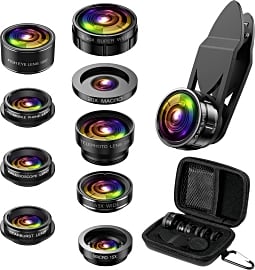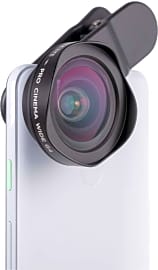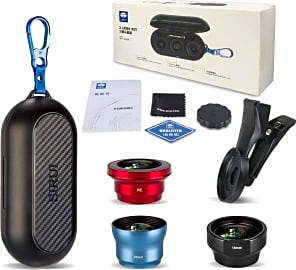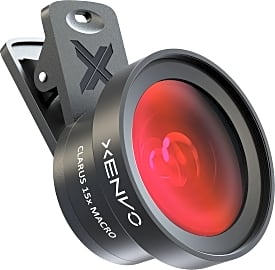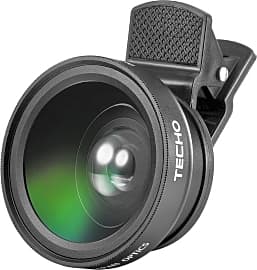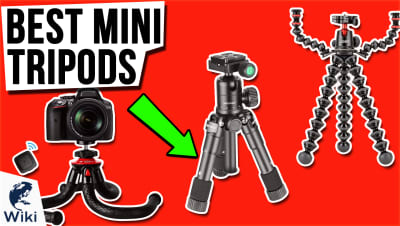The 8 Best Wide Angle Phone Lenses

This wiki has been updated 35 times since it was first published in October of 2016. Today's smartphones come equipped with cameras that rival even the best point-and-shoots out there, but that doesn't mean you can't enhance your device's photo-taking capabilities. By reproducing the effects of DSLR or mirrorless lenses, these wide-angle phone attachments will let you improve your skills and take even more impressive panoramic, landscape, and group pictures. When users buy our independently chosen editorial choices, we may earn commissions to help fund the Wiki.
Editor's Notes
April 15, 2021:
We removed the Aukey Ora, BullyEyes Easy Clip and Anazalea Super Wide, all due to availability issues. We also replaced the Criacr 5 in 1, which seemed to be missing in action, with the Criacr 9 in 1, which is essentially the same kit, just with a few more bells and whistles. It also comes with a zippered storage case, instead of the compact cylinder the company offers with its 3-in-1 and 5-in-1 kits. Both solutions seem to be serviceable, but if you prefer the cylinder and don’t think you’re likely to use the extra lenses, then you may want to opt for a smaller set.
We also added the CoPedvic PLK-01 to our list, which caught our eye with its included mini tripod and 22x telephoto lens. The telephoto glass is a nice touch, but before you go getting too excited about it, it should be noted that it’s a fixed-length model, so while it does boost your smartphone’s utility, it won’t provide any zoom functionality.
For further gear to help take your smartphone-photography game to the next level, check out our rankings for face-tracking gimbals.
January 10, 2020:
Despite the fact that you will have to purchase a compatible case to use it, the Moment 18mm Wide is still a top choice to beat, as it offers quality that many of the off-brand, low-budget options simply cannot match. We've added the Black Eye Pro Cinema Wide G4 and the Sirui 3 in 1 Kit, as well, either of which can help take your "iPhoneography" to new heights. For those who are looking for options a little less pricey, we've selected the Criacr 5 in 1 and kept the Aukey Ora. These are simple and affordable, and each is designed with an eye toward excellent portability. We like the Ztylus Designer Revolver M Series, too, especially since each comes with an eye-catching and matching case. This model doesn't offer universal compatibility, though, and won't allow for wireless charging, like many iPhone X cases do. Finally, we ultimately opted to remove the Olloclip Active Set, as it has been known to occasionally scratch the iPhone; this may not be likely, but for most, the risk isn't worth it.
Special Honors
Sandmarc Wide Lens Designed for the iPhone 11 Pro Max, the Sandmarc Wide Lens may cost a pretty penny, but it works well in low light conditions and boasts one of the thinnest lens cases you can find. And, of course, it offers top-notch, multi-coated optics. sandmarc.com
DJI Pocket 2 Lenses like the ones on this list are a great way to start bolstering your creative abilities, but as your journey progresses there's a good chance that you'll want to start moving away from smartphones and more toward specialized camera gear. If that's where you're at right now, this is one relatively affordable gadget that can help with your transition. You can use it as a standalone unit, or in combination with your smartphone (if you prefer a bigger screen), and you can even take it underwater — with the additional purchase of a case. dji.com
What Lens Should You Get For Your Phone?
This new wave of hobbyists have not paid their dues in many ways.
Lens attachments for smartphones have become very popular recently, especially as the quality of smartphone cameras increases. This new wave of hobbyists have not paid their dues in many ways. Using Ansel Adams’ Zone System is practically a lost art form, yet if the end result is breathtaking, it may not matter. Modern digital sensors adjust themselves in milliseconds, providing the perfect exposure in many situations. For most photographers, this is beyond satisfactory. The calculations and considerations of old are gone, replaced with the popular phrase, "We’ll fix it in post."
Yet where some people see a loss of history, others see progress. In fact, most smartphone photographers seek to add to this ease by using attachments like clip-on phone lenses. The idea is normal in the photography world, but near genius in its application in the smartphone world. These attachments take the sub-optimal lens provided by many smartphones and make it better by fitting various lenses to the outside of the phone. Before choosing one, it is important to understand what kind of lens will give you the shots you want.
A wide angle phone lens shortens the focal length of the phone’s standard lens. This allows the photographer to fit a wider angle of view into the frame, without switching the phone to a questionable panorama mode. Wide angle phone lenses are good for fitting a large group of people into one photo, but may find their best use in landscape photography. Wide angle phone lenses allow the user to capture a picture much closer to what they are seeing with their own eyes.
A macro lens is another common attachment for phones. Macro lenses allow cameras to focus on objects extremely close to them, while sacrificing the ability to focus on anything at normal ranges. Fisheye lenses are another common phone attachment. They are like wide angle phone lenses, but are more specialized, as the image they create has limited practical application. Fisheye lenses create extremely wide images by curving lines that would normally be straight. A fisheye lens can often produce a circular or oval image with a 180-degree field of view, which is great for very large panoramic photos or simply distorted images. The right lens for you will change depending on what kind of image you would like to take. If you can't decide, many phone photography kits will contain multiple types of lenses, so you can switch them out as needed.
Do Wide Angle Phone Lenses Spell The Future Of The Photography Industry?
As with nearly every industry, mobile has disrupted the photography industry in a big way. Global smartphone use is on the rise as the technology becomes more available than ever before. Much to the ire of photography purists and elitists, smartphone photography is here to stay — and it's getting better. Recent research found that smartphones accounted for nearly 27 percent of photos in recent years, a number that has grown year after year. The number of photos shot from dedicated cameras has taken a corresponding dive each year, down to 44 percent by recent calculations. Even dedicated photographers understand that a smartphone with an added lens is good enough for may applications. With advancements in technology being made seemingly every other day, that good enough will turn into just as good in no time.
The number of photos shot from dedicated cameras has taken a corresponding dive each year, down to 44 percent by recent calculations.
The largest impact in the current market is on the lower end of photography. Low-end point-and-shoot cameras and video cameras are taking a dive as smartphone use is on the rise. Many people cannot see the need of carrying a dedicated camera in one pocket while they have a smartphone with an acceptable camera in the other pocket. On the other hand, this renewed interest in photography may actually be good news at the higher end of the market. There is currently no equal to a DSLR or mirrorless camera as far as quality goes, and recent trends show that high-end cameras are enjoying more popularity than ever. It may be that as photography becomes more user friendly, people realize their passion for the craft and dedicate themselves to a better camera.
Currently, a high-end camera beats a smartphone in every way except the price tag. The ability to shoot in RAW and edit in post, provide more detail and less noise, even a proper zoom function all make the DSLR or mirrorless camera the better choice for photography. However, given advancements in smartphone gadgetry like wide angle phone lenses, the future may hold an entirely different picture.
The History Of Camera Lenses
The wide angle phone lens is the most telling sign of the times in photography. Our curiosity and love of beauty leads to the desire to capture art with every step, but our need for convenience means we don’t want to carry yet another device around to do so. It is impressive that the world of photography has evolved so quickly since its inception, yet the concepts of photography date back thousands of years. The ancient Chinese philosopher Mozi was the first to develop the principles of optics and the camera obscura.
Their very basic cameras used single-element convex lenses.
Thomas Wedgwood then made the first attempt to save a camera obscura image, though it was Niepce who created the earliest surviving photograph. Their very basic cameras used single-element convex lenses. The trouble with these lenses is a noticeable inability to focus an entire image. The Meniscus lens would soon follow, which allowed the user to produce an entire image in reasonable focus, rather than just one point. The portrait lens followed shortly after, and photography took off.
Soon, scientific minds and hobbyists from around the globe were trying to create the best lenses to overcome optical aberrations. The sheer number of lenses produced in the 19th and 20th centuries alone is astounding, and the early era created many variants we still use today. For example, the first wide angle lens was a variant of early Tessar lenses. While a modern wide angle phone lens is worlds ahead of the original lenses of the day, the basic design remains largely unchanged.


